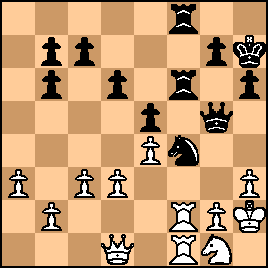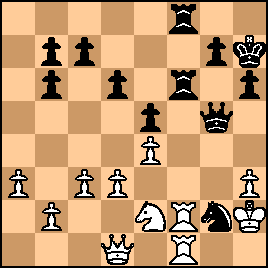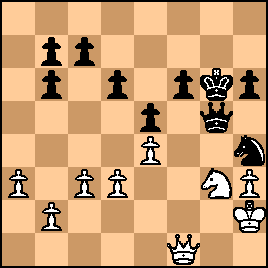Jan-06-09
 | | Honza Cervenka: 24.Ne2 was a blunder allowing white a pretty little winning combination. Instead of 25...Rxf6 much devastating would have been 25...Ne3! |
|
Jul-11-15
 | | Pawn and Two: At move 19, Houdini indicates the game was approximately equal: (.16) (27 ply) 19.g3 Qe6 20.a3 Kg8 21.Kg2 b5, or (.00) (27 ply) 19.Qc2 Qe6 20.a3 Nf4 21.Kh2 Rf6, or (.00) (27 ply) 19.a3 Nf4 20.Qe3 Qe6 21.Kh2 Rf6 22.Ng1 Raf8 23.Ne2 Nh5 At move 24, White could have continued with only a minimal disadvantage: (-.23) (27 ply) 24.Nf3! Qh5 25.Ng1 Qg6 26.Nf3 Nh5 27.g4 Nf4 28.Nh4 Qe8 29.Ng2 Qb5 30.Nxf4 exf4. As pointed out by <Honza Cervenka>, after 24.Ne2?, Black should have played 25...Ne3!, and with his mate threat, Black would have obtained a clearly winning material advantage: 26.R1f2 Nxd1 27.Rxf8 Nxf2 28.Rxf2 Qd2. After 25...Rxf6? 26.Rxf6 gxf6, White had some possibilities for a draw: (-1.19) (26 ply) 27.Qb3! Ne3 28.Qf7+! Qg7 29.Qxg7+! Kxg7 30.Kg3, (-1.24) (29 ply) 30...f5 31.exf5 b5 32.Kf3 Nxf5 33.Ke4 Kf6. White was probably lost by move 29, but (-1.52) (28 ply) 29.Qf2 b5, provided more resistance than 29.Nf5? Nxf5 30.exf5+ Qxf5 31.Qg2+ Qg5 32.Qxb7. At move 32, Black could have easily won with: (-3.95) (26 ply) 32....Qf4+! 33.Kg2 Qd2+ 34.Kg1 Qc1+ 35.Kg2 Qxb2+ Instead, Black played for the exchange of Queens, which was also winning: (-1.75) (26 ply) 32...Qd2+ 33.Qg2+ Qxg2+ 34.Kxg2. At move 35, a note in Gillam's tournament book, states that 35.b4 was an unintelligible move, and that 35.b3 was clearly much better. While 35.b3 is clearly a better move than 35.b4, Houdini verifies that White was lost at move 35, regardless of the move selected: (-3.06) (31 ply) 35.b3 Kf5 36.Kf3 Ke6 37.Kf2 c5 38.Ke2 f5 39.Kd2 d5; (-17.12) (35 ply) 35.b4 d5! 36.Kf3 f5 37.Kg3 Kg5. Other choices for White at move 35 are not an improvement over 35.b3. Instead of 35....d5!, Black played 35...Kf7, but this move was also easily winning for Black: (-8.83) (33 ply) 36.Kf3 f5 37.c4 c6 38.Ke3 Kf6, or 37.Ke3 d5. Gillam's tournament book states that other sources for this game give 35.Kf2 as the move played, instead of 35.b4. In any case, the move 35.Kf2, is also losing for White: (-3.02) (31 ply) 35.Kf2 Kf5 36.c4 bxc4 37.dxc4 c5 38.h4 Ke6 39.a4 f5. |
|
Sep-14-21
 | | KEG: In a relatively even position that looked as if it would reduce to a draw, Mieses blundered on move 24. Tarrasch soon finished him off, though he missed an even stronger line on move 25. Going into this 5th round game, Mieses was 3-0 (with one bye) while Tarrasch had only 0.75 points out of four. Their fortunes turned around with this game; Tarrasch won and finished in a tie for 5th place; while Mieses wound up with a slight minus score and finished 12th. 1.e4 e5
2. Nc3
The Vienna Game; Mieses' favorit opening.
2... Nf6
4. Bc4
This should probably be called the Mieses Variation. He had played it at least 15 times before this game and played it at least 28 times after. The line was later employed frequently by Alekhine. 3... Bc5
4. d3
Mieses' favorite variation in this opening. It became a favorite of Rudolph Spielmann after this game. 4... d6
5. f4?!
Mieses was partial to the Vienna Gambit.
5... Bg4
5...Ng4 is probably theoretically best here for Black. But Tarrasch preferred to transpose into a kind of King's Gambit Declined. 6. Nf3 Nc6

click for larger view7. h3
7. Na4 or 7. Bb5 are probably better. But the text was a frequent choice of Tchigorin and Rubinstein. I am always reluctant to second-guess Tchigoin's handling of the White side of King's Gambit. 7... Be6?
Black seems to get an immediate advantage with the simple 7...BxN and 8...Nd4. 8. BxB fxB
9. Na4 Bb6
9...exf4 looks simpler and better.
10. NxB axN
11. 0-0
The Comments in the Tournament Book notwithstanding, White can get the better game with 11. fxe5. 
click for larger view11.. exf4
12. Bxf4 0-0

click for larger viewMieses now had to decide how we would deal with Tarrasch's threat of Nxe4. 13. Bg5
Of all the possible ways to deal with Tarrasch's threat, this (as compared with 13. Be3; 13. Bh2; 13. Qe2; or 13. Qd2) would probably be my last choice, especially in conjunction with Mieses next move. 13... h6
14. BxN
Was this Mieses' intention when he played 13. Bg5? If so, I don't get it. 14... QxB
15. c3
One of several ways (and arguably the best way) to protect the b2 pawn. 15... Kh7
Another mystery move. It isn't any kind of blunder, but 15...Ne5 or 15...Qg6 or 15...Qf4 or even 15...Qe7 look more promising. 
click for larger viewNot much edge for either side here. I might have predicted a draw if Mieses had not been one of the participants. |
|
Sep-14-21
 | | KEG: Post II
16. Qe2 e5
17. Rf2 Ne7
18. Raf1

click for larger view"Threatening Nxe5. This threat is easily parried by Black's next move, when White must lose a tempo with a3 and allow the Knight into f4." (Tournament Book) All true, but there was nothing wrong with the text nonetheless. White's position is solid, and his only weakness (a2) can be addressed on his next move. 18... Ng6
19. a3
<Pawn and Two> reports that, according to Houdini rates the game as approximately even at this point. Fritz and Stockfish basically agree, giving White only a minimal advantage. 19... Nf4
20. Qd2 Rf7
21. Kh2 Raf8
22. Ng1 Qg5

click for larger view"Preventing 23. g3 as Black would be able to gain the advantage by 23...Bxh3." (Tournament Book) Indeed 23. g3 would lose immediately. Even stronger than 23...Bxh3 would be the murderous 23...Nxd3. Mieses did not in fact err with 23. g3?, but time pressure was becoming a factor (given the move 30 time control at that time), and both sides were soon to be affected. 23. Qd1
Not terrible, but 23. Nf3 or 23. Qc2 were better and might have avoided the tragedy that was to befall Mieses on his next turn. 23... Rf6

click for larger view24. Ne2?
"?"--(Tournament Book)(<Pawn and Two>) "24. Ne2 was a blunder, allowing a pretty little winning combination." (<Honza Cervenka>) The position was now:

click for larger viewBlack to move and win.
24... Nxg2!
"!"--(Tournament Book)
Pretty. White is busted:

click for larger view25. RxR
There was nothing better.
This left:

click for larger viewBlack to play and win. |
|
Sep-15-21
 | | KEG: Post III
25... RxR?
"?"--(Tournament Book)(<Pawn and Two>) "In time trouble, Dr. Tarrasch misses the powerful move 25...Ne3." (Tournament Book) "Much more devastating would have been 25...Ne3!." (<Honza Cervenka>) (see also <Pawn and Two>). There is no doubt that 25...Ne3 was the killing move and would have rendered further resistance useless (25...Ne3 26. R1f2 NxQ 27. RxR NxR 28. RxN Qd2 after which White--already behind in material--gets massacred). My sole quibble with <Pawn and Two> is with his assessment that White had drawing chances after the text. As I will attempt to show, Tarrasch's move, while lengthening the winning process, was more than sufficient to win. Since he was in time trouble, his choice is understandable. 26. RxR gxR

click for larger view27. Ng3
<Pawn and Two> contends that with 27. Qb3 instead of the text "White has some possibilities for a draw." But--following his line--after 27. Qb3 Ne3 28. Qf7+ Qg7 29. QxQ+ KxQ 30. Kg3 f5 31. exf5 b5 32. Kf3 Nxf5 33. Ke4 Kf6, the win for Black in the Knight and Pawn ending seems clear, and not solely or primarily because of his extra pawn. The position at the end of the line given by <Pawn and Two> would have been: 
click for larger viewIf now--to consider just one plausible line--34. d4 c6 35. d5 Ne7 36. dxc6 d5+ 37. Kd3 bxc5 we reach a position in which I would fancy my chances against Magnus Larsen (i.e., a pretty clear win). Mieses' actual 27. Ng3 was no great shakes for White either, but it was not any worse than 27. Qb3. 27... Nh4!
28. Qf1 Kg6
28...b5 would also have won.
After 28...Kg6, the position was:

click for larger view29. Nf5
"?"--(<Pawn and Two>) <Pawn and Two> is surely correct that: "White was probably lost by move 29, but 29. Qf2 b5 would provide more resistace." Beyond doubt, 29. Nf5 made Tarrasch's task easier. 29... NxN
30. exN+ Qxf5
31. Qg2+ Qg5
31...Kh5 is also a win for Black.
32. Qxb7

click for larger viewTarrasch now had an interesting choice. In fact, as I will discuss, the game was won for him whichever option he chose. |
|
Sep-15-21
 | | KEG: Post IV
32... Qd2+
As <Pawn and Two> has demonstrated with his usual thorough analysis, Tarrasch could have won with ease with 32...Qf4+. I have nothing to add to his convincing analysis. But, as <Pawn and Two> has also correctly stated: "Black [with the text] played for the exchange of Queens, which was also winning." 33. Qg2+ QxQ+
34. KxQ

click for larger viewAs Tarrasch had foreseen, this is a winning ending for Black. 34... b5
One of several winning lines for Black. It left the position as follows: 
click for larger viewThe tournament Book gives Mieses' next move as:
35. b4.
The Tournament Book rightly called this move "unintelligible." The Tournament Book gave 35. b3 as a better choice, and cites sources that said that what was actually played was 35. Kf2. I am not going to belabor this issue since White is dead lost in any case. According to the Tournament Book, the game concluded after the alleged 35. b4 as follows: 35... Kf7
36. Kf3 f5

click for larger view0-1 |
|
|
|
|





